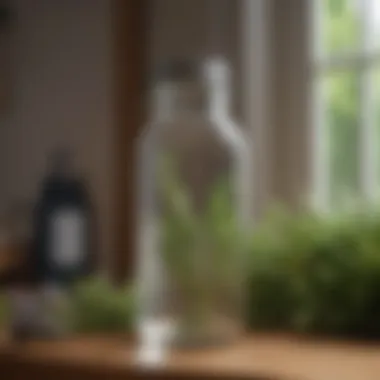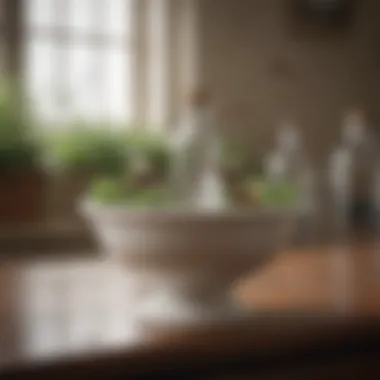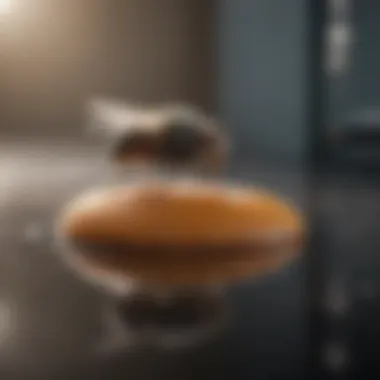Eliminate House Flies Effectively with White Vinegar


Intro
House flies are often seen as mere nuisances, but their presence in our homes signals something deeper. They find their way into our living spaces searching for food and warmth. Understanding why these pests invade our homes informs how we can repel them effectively. This article centers on the use of white vinegar, a common household item, and its surprising efficacy in managing house fly populations.
White vinegar is not just a condiment. Its acetic acid content creates an environment that is unwelcoming to flies. This article will break down the techniques to harness white vinegar effectively in your quest for a fly-free home.
Key Insights and Trends
Understanding House Fly Attraction
House flies tend to gravitate towards specific scents, particularly those that emanate from rotting food or organic waste. They thrive in environments that provide ample food sources. By eliminating these attractants and introducing deterrents like white vinegar, homeowners can significantly reduce fly populations.
The Role of White Vinegar in Fly Control
White vinegar has a dual role: it repels flies while also cleaning surfaces that may harbor food particles and odors that attract them. This aspect is crucial in homes where cleanliness is paramount. Utilizing white vinegar not only addresses the fly problem but also ensures the environment remains hygienic.
"An ounce of prevention is worth a pound of cure."
In the context of house flies, preventative measures are far more effective than reactive ones. Implementing vinegar solutions early can save homeowners from larger infestations later.
Practical Tips and How-To Guides
Step-by-Step Guide to Use White Vinegar Against House Flies
- Create a Vinegar Trap
Combine equal parts white vinegar and water in a bowl. Cover the bowl with plastic wrap and secure it with a rubber band. Poke small holes in the wrap. The flies will enter but won't escape. - Surface Spray
Mix one cup of white vinegar with water in a spray bottle. Use this mixture to clean counters, tables, and any surfaces where food is often prepared. The strong scent will deter flies from returning to those areas. - Infuse with Essential Oils
For an enhanced repelling effect, add a few drops of essential oils like peppermint or eucalyptus to your vinegar mixture. Flies dislike these scents, giving an additional layer of protection. - Regular Maintenance
Consistency is key. Reapply the vinegar solution and traps regularly. Ensure that garbage is regularly disposed of, and surfaces cleaned to lessen the chances of attracting flies.
By applying these techniques, homeowners will find that white vinegar serves as a powerful ally in the battle against house flies. The simplicity of using a common kitchen item makes these methods accessible and practical for all.
Epilogue
Managing house flies requires an understanding of their behavior and effective use of deterrents like white vinegar. This household staple is not only a cleaning agent but also a formidable foe against pests. By following the outlined techniques, you can maintain a clean and fly-free home environment.
Prolusion to House Flies
House flies are more than just a nuisance in our homes; they are vectors for disease, contaminating food and spaces where we live and socialize. Understanding the intricacies of these pests, their biological traits, and their behavioral patterns is essential for effective control methods. This article aims to provide insights into house flies, particularly focusing on the use of white vinegar as a solution for their management.
Knowing how house flies operate helps in the development of strategies to deter their presence. It is crucial to identify their biological traits since they play a significant role in their infestation behavior. Before exploring remedies, it is valuable to understand the sources that contribute to their prevalence in and around households.
Biology and Habits
A fascinating aspect of house flies is their resilience and adaptability. Scientifically known as Musca domestica, these insects exhibit omnivorous feeding habits, thriving in various environments. Their life cycle consists of four stages: egg, larva, pupa, and adult. Females can lay hundreds of eggs in decaying organic matter, which offers insight into their rapid population growth. House flies are often attracted to moist environments and decaying materials, which serve as food sources for their larvae.
Additionally, house flies possess sharp olfactory sensors that help them locate suitable habitats. They are often active during the day, and their short life span—which averages around 15 days—does not significantly deter their ability to create serious infestations in that short time.
Common Infestation Sources
Identifying common sources of infestation is crucial for any proactive approach to fly management. House flies are typically drawn to areas with abundant food, waste, and moisture. Some primary sources include:
- Garbage: Open trash cans that are not properly sealed attract flies significantly.
- Pet Waste: Areas where pets relieve themselves are prime breeding grounds.
- Compost Bins: These provide both food and suitable conditions for flies to thrive.
- Food Preparation Areas: Leftover food and spills can easily invite unwanted guests.
- Wet Areas: Leaky pipes or damp surfaces can create ideal habitats.
Preventive measures against flies should address these sources directly. By targeting where flies commonly thrive, it can significantly reduce their chances of infiltrating a home.
Understanding White Vinegar
White vinegar serves not only as a culinary ingredient but also as an effective tool for pest control, particularly in managing house flies. To fully comprehend its utility, it is crucial to analyze its composition and historical application in pest management. This section reveals the multifaceted benefits of white vinegar, making it a staple amongst homeowners.


Composition and Properties
White vinegar is primarily composed of acetic acid, typically containing around 4% to 7% acetic acid diluted in water. This simple chemical makeup gives white vinegar its distinctive sour flavor and pungent aroma. The acetic acid is responsible for the repellent properties against various insects, including house flies.
One notable property of vinegar is its ability to alter environments in ways that are unappealing to pests. For instance, the strong scent of vinegar can mask the odors that attract flies, effectively deterring them from entering treated areas. Furthermore, its acidic nature makes it a challenging environment for fly larvae, reducing the chances of an infestation.
In addition to its pest-repelling qualities, white vinegar's antibacterial properties contribute to its effectiveness as a cleaning agent. When used on surfaces, it not only removes residues that may attract flies but also disinfects, leaving a clean area less likely to harbor pests. This dual functionality ensures that when flies are deterred, cleanliness is also maintained within the home.
Historical Uses in Pest Control
The use of vinegar for pest control is not a recent discovery. Historically, many cultures have utilized various forms of vinegar as natural insect deterrents. Ancient civilizations recognized vinegar’s preservative qualities and its ability to hinder insect populations. For example, the Babylonians, Romans, and Greeks used vinegar in conjunction with other natural substances to ward off pests.
Over the years, enthusiasts have documented the efficacy of vinegar in personal gardens, kitchens, and livestock areas. The knowledge of vinegar's utility has been preserved and adapted over generations, culminating in its recognition as a reliable household remedy.
Research indicates that the effectiveness of vinegar in combating house flies can be attributed to its strong scent and active compounds that disrupt the flies' sensory capabilities. For those aiming to maintain a clean and pest-free environment, understanding these historical applications not only emphasizes vinegar's reliability but also promotes a more sustainable approach to pest management without resorting to harsh chemicals.
"White vinegar is a versatile product that combines cleaning power with pest control, creating a dual action solution against house flies."
Why White Vinegar Deters House Flies
White vinegar stands out as a practical solution for managing unwanted house flies due to its unique properties. Flies are not merely a nuisance; they can pose health risks by contaminating food and surfaces. Therefore, understanding why white vinegar is effective becomes essential for homeowners.
This section delves into several key elements that underline the effectiveness of white vinegar in deterring house flies. Its non-toxic nature makes it safe for use around children and pets, a significant advantage over commercial pesticides. Using white vinegar in pest management aligns with growing preferences for natural methods in households.
Conducting Research on Fly Sensitivity
Current research focuses on understanding how house flies react to various substances, including vinegar. Several studies show that house flies possess a strong aversion to certain odors. White vinegar, with its pungent scent, works effectively to repel these insects.
One crucial study highlights that flies are sensitive to acetic acid, the primary component of vinegar. This component is what creates the strong smell that flies find unappealing. Research indicates that even small concentrations of white vinegar around areas prone to fly infestation can make a noticeable difference.
While not all flies respond equally, house flies typically exhibit significant sensitivity to the scent. This sensitivity makes vinegar a valuable tool in reducing their presence indoors.
Chemical Repellency Mechanisms
The chemical properties of white vinegar play a significant role in its ability to deter house flies. The acetic acid within white vinegar not only produces a strong odor but also creates an unfavorable environment for flies. Flies try to avoid environments where they cannot detect their usual food sources, as an aversion could signify that these places might be unsuitable for survival.
Additionally, the acidity level in vinegar may disrupt the flies' ability to find food. It interferes with their navigation, making it harder for them to locate suitable breeding or feeding grounds. Thus, the strong chemical composition of white vinegar affects fly behavior, reinforcing its use as a repellent tool within homes.
Methods for Using White Vinegar
Using white vinegar is a practical approach to mitigating house flies. Its effectiveness lies not only in its pest-repellent properties but also in its versatility. Homeowners can utilize this common household item in multiple ways to eliminate flies and maintain a clean, pleasant environment.
Creating a Vinegar Trap
Materials Needed
To construct an effective vinegar trap, it is crucial to gather the right materials. The primary component is, of course, white vinegar. This vinegar type is preferred due to its strong scent that attracts flies. In addition, you will need a container, preferably glass or plastic, which can be shaped to facilitate fly entry and capture. Finally, a piece of plastic wrap may be necessary to cover the container's top. This setup allows flies to enter but does not let them escape.
The blend of these materials contributes significantly to the overall effectiveness of the trap. White vinegar, being easily available and inexpensive, makes it a common choice in households. While other types of vinegar might work, white vinegar's efficacy is well-documented and widely trusted.
Step-by-Step Instructions
Creating a vinegar trap is a straightforward task. Here is a clear method: 1. Pour about half a cup of white vinegar into your chosen container. 2. Cover the top with plastic wrap, ensuring it is tight. 3. Poke small holes in the plastic wrap, just large enough for flies to enter. 4. Place the trap in high-traffic areas where you've noticed fly activity. This process is efficient and does not require complex tools or ingredients.
The simplicity of this method appeals to many. It is easy to follow, and the materials are often already at hand. The trap's effectiveness may vary based on placement but remains a beneficial strategy overall.
Placement Recommendations


For a vinega trap to work its best, its placement is vital. You should consider areas that attract flies, like kitchens, garbage disposal zones, or near food source locations. Good spots include countertops or near fruit bowls, as these attract flies naturally due to odors.
Moreover, ensure that the trap is in a well-lit area. Flies tend to fly towards light, which increases the likelihood of them entering your trap. However, avoiding overly windy locations is also essential, as airflow may disturb their movement. Strategic placement enhances the trap's effectiveness and ensures you are more likely to catch flies.
Diluting Vinegar for Surface Cleaning
Effective Ratios
Diluting white vinegar can be an excellent method for cleaning while deterring flies. The ratios usually depend on the cleaning purpose. For everyday cleaning, a 1:1 ratio of vinegar to water is often effective. This mix maximizes its cleaning properties while also maintaining its pest-repelling qualities.
Such a dilution is practical. It is neither too strong nor too weak, allowing for thorough cleaning. However, certain surfaces, like natural stone or specific types of wood, may suffer from prolonged vinegar exposure. Understanding these ratios helps maximize efficacy while minimizing potential damage.
Application Techniques
The application of diluted vinegar can be approached in various ways. A spray bottle works well for applying the solution onto surfaces. You can easily target areas where flies land. Damp cloths can also be useful for wiping down surfaces to ensure cleanliness. Simply dip the cloth into the solution and wipe down counters or tables.
These techniques contribute towards not only cleaning but also reducing the overall presence of flies. The scent of vinegar acts as a deterrent, making surfaces less attractive to these pests. However, while effective, frequent application may be necessary, especially during peak fly season.
Using white vinegar can provide both immediate and ongoing solutions for house fly management. A consistent approach yields better results.
By implementing these methods with white vinegar, you can address fly problems at their source. Whether through traps or cleaning solutions, homeowners can reclaim the comfort of their spaces.
Preventive Measures Against House Fly Infestations
Preventing house fly infestations is essential for maintaining a comfortable and hygienic home environment. House flies are not just a nuisance; they can also pose health risks as they can carry germs and diseases. Therefore, taking proactive steps to prevent them from entering or breeding in your space is crucial. In this section, we will discuss effective strategies that can significantly reduce the chances of house flies invading your home.
Maintaining Clean Environments
A clean environment is the first line of defense against house flies. Flies are attracted to rubbish, food scraps, and spoiled items. Here are some important points to keep in mind:
- Regular Cleaning: Ensure regular cleaning of all surfaces, especially those in kitchens and dining areas. Wipe down counters, tables, and other surfaces to remove food residues.
- Proper Waste Disposal: Use tightly sealed trash bins for garbage and compost. Ensure that food waste is disposed of immediately and not left exposed, as it attracts flies quickly.
- Cleaning Up Spills: Flies will be drawn to spills on floors, dining tables, and other areas. Clean up any spills promptly to eliminate attractants.
- Maintaining Pet Areas: If you own pets, ensure their feeding areas are kept clean. Pet food should not be left out for long, as this can attract flies. Regularly clean the area where your pets eat and play.
These simple actions not only keep your home looking tidy, but they also create an environment less conducive to fly breeding.
Sealing Entry Points
Another effective strategy for preventing house fly infestations is to seal points of entry. House flies can enter your home through tiny cracks and openings. Here are key measures to consider when sealing your home:
- Inspect Windows and Doors: Check for gaps around windows and doors. Install weather stripping or screens to prevent flies from entering when windows or doors are open.
- Sealing Cracks: Regularly inspect your walls, especially near pipes and wiring. Use caulk to seal any cracks or holes in your home’s structure.
- Using Fly Screens: Install fly screens on windows and doors. This additional barrier allows fresh air to circulate while keeping flies out.
- Checking Vents: Inspect ventilation systems, particularly kitchen and bathroom vents. Ensure they have screens to limit fly access.
By sealing these entry points, you go a long way in reducing the incidence of house flies in your living space, allowing a more tranquil home without the incessant buzzing of unwanted guests.
Alternative Natural Remedies
In the quest to keep house flies at bay, exploring alternative natural remedies offers homeowners effective options that align with ecological sensibilities. While white vinegar plays a significant role in repelling these pests, incorporating other household ingredients can enhance the overall effectiveness of fly control strategies. This section elaborates on the nuanced benefits of embracing natural remedies, their ease of access, and their role in promoting a healthier living environment.
Drawing on common household substances can simplify the process of managing pest populations. Natural solutions diminish reliance on chemical sprays and treatments that might pose health risks, especially in homes with children and pets. The following sections will delve into specific alternative remedies, allowing for a more comprehensive perspective on how to deal with fly infestations.
Essential Oils and Their Efficacy
Essential oils are highly concentrated plant extracts that have been known for various benefits, including repelling insects. The distinct scents of oils such as peppermint, lavender, and eucalyptus can disrupt the olfactory senses of house flies, making these areas less attractive to them.
Some common essential oils to consider include:
- Lavender Oil: Known for its calming properties, lavender also serves as an effective fly repellent. Simply mix a few drops with water in a spray bottle and apply it to areas where flies frequent.
- Peppermint Oil: The sharp scent of peppermint is often overwhelming for house flies. A blend of peppermint oil and water can create a natural fly deterrent that can be sprayed indoors.
- Eucalyptus Oil: This oil has a potent smell that flies find unpleasant, making it suitable for repelling them effectively.


Using these oils generally involves mixing them with a carrier fluid like water or vinegar before applying them as a spray. This simple approach not only deters flies but can also freshen up the living space. However, it is critical to test a small area first to ensure no adverse reaction occurs.
Other Household Ingredients
Aside from essential oils, several other household ingredients can complement the use of white vinegar in eliminating house flies. Some of these include:
- Basil: Flies tend to shy away from basil. Placing pots of basil around your home can act as a natural barrier.
- Cinnamon: The fragrance of cinnamon can repel many insects, including flies. Sprinkling cinnamon in areas like windowsills can reduce fly activity.
- Bay Leaves: These leaves have insect-repelling properties. Leaving them in cabinets or closets can help keep flies away from stored food.
Implementing these options requires minimal preparation and is budget-friendly. Such remedies provide versatile choices, enabling homeowners to experiment and find methods that suit their specific environments.
By employing an arsenal of natural remedies, you can cultivate a flying pest-free home while contributing positively to your environment.
Culmination
In this article, we have explored various effective techniques to eliminate house flies, focusing particularly on the use of white vinegar. This discussion underscores the significance of addressing fly infestations in our homes, as these pests can not only be a nuisance but can also pose health risks. Understanding the behavior of house flies and how they interact with their environment is crucial.
White vinegar, with its unique properties, serves as a practical solution for managing these pests. It acts as both a repellent and a cleaning agent, making it two-fold advantageous in fly control. The methods outlined highlight the simplicity and efficiency of vinegar, showing that homeowners need not rely on harsh chemicals that may have more detrimental effects on their living spaces.
As we summarize the strategies discussed, it is essential to recognize that maintaining a clean environment, sealing entry points, and using natural remedies like white vinegar are critical steps for sustaining a fly-free home. By integrating these techniques regularly, you can effectively manage and prevent infestations.
"Simple solutions often lead to the best outcomes in pest control."
Through this article, readers should feel empowered to take action and utilize white vinegar not just as a fly repellent but as a holistic approach to pest management throughout their homes.
Recap of Effective Strategies
To consolidate what we have covered, here are the key strategies for using white vinegar effectively against house flies:
- Creating Vinegar Traps: This method involves mixing vinegar with a sweet liquid to attract flies, then trapping them within the container.
- Surface Cleaning with Vinegar: Diluting vinegar with water and using it as a cleaning solution can help eliminate odors that attract flies.
- Maintaining Hygiene: Regular cleaning routines can significantly reduce the likelihood of attracting flies.
- Sealing Entry Points: Checking for gaps and sealing them helps to prevent flies from entering your home.
These strategies emphasize the importance of proactive measures in controlling fly populations effectively.
Encouragement to Explore Simple Solutions
It is essential for homeowners and anyone interested in pest management to understand that some of the simplest solutions can be the most effective.
White vinegar is not just a culinary staple; it has notable properties that can keep your home environment pleasant and safe. By experimenting with different methods of using vinegar, you may discover combinations that work best in your specific situations. Consider:
- Trying varying concentrations of vinegar in cleaning solutions to find the most effective mix for your home.
- Involving the entire household in maintaining cleanliness to create a united front against infestations.
In stepping away from commercial pest control methods, you empower yourself to maintain a healthier living space. White vinegar offers a sustainable alternative, letting you address pest issues with confidence and efficiency. Embracing such simple solutions not only simplifies the process but also enhances your home environment.
Further Reading and Resources
Understanding how to eliminate house flies using white vinegar can be enhanced by delving deeper into related academic and practical materials. The significance of exploring further reading and resources lies not only in broadening one’s knowledge of the subject but also in providing practical insights into pest management. By studying scientific research and home remedy literature, individuals can gain a more refined approach in their quest for effective solutions against household pests.
Scientific Articles on Fly Behavior
Accessing scientific articles that discuss fly behavior provides critical insights. These studies often outline the lifecycle, breeding patterns, and attraction mechanisms of house flies. Notable articles may highlight findings on how environmental factors influence fly presence indoors. Understanding these behaviors can aid homeowners in implementing highly targeted preventive measures. For instance, certain studies indicate that house flies are attracted to decaying organic matter. Consequently, homeowners can focus on areas in their home that may harbor such materials, improving their cleaning routine.
Here are a few key benefits derived from looking into scientific articles on fly behavior:
- Enhanced Knowledge: Gain insights into specific attractants that invite flies.
- Informed Decision-Making: Utilize evidence-based strategies when employing vinegar solutions.
- Understanding Longevity: Learn about the lifespan of house flies to better time interventions and preventive measures.
Books on Home Remedies
Books focusing on home remedies present another avenue for valuable information regarding natural pest control methods. These texts often provide recipes, tips, and anecdotes concerning how various household items, including white vinegar, can serve in pest management. They highlight the versatility of vinegar beyond cooking, underscoring its practical applications in cleaning and deterring pests.
Some essential aspects to consider when exploring books on home remedies include:
- Practical Tips: Many books compile user-friendly techniques that anyone can adopt at home.
- Historical Context: These resources often share insights about the historical usage of various ingredients for pest control, including vinegar’s longstanding role.
- Comparative Analysis: Readers can discover other natural remedies and how they stack up against white vinegar in efficacy.
Incorporating this knowledge from both scientific articles and home remedy books elevates the understanding of how to effectively manage house flies using white vinegar. Given the importance of actionable insights, these resources empower homeowners to maintain a more pleasant living environment.



